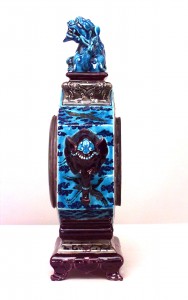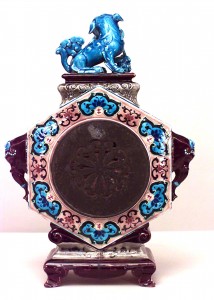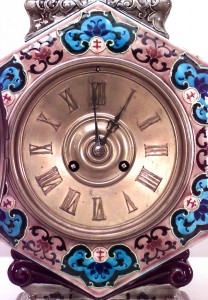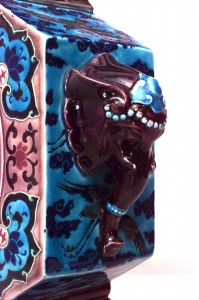X
{{ modalTitle }}
PLEASE FILL IN THE REQUIRED FIELDS.X
X
{{ modalTitle }}
Choose one of the options below.X
ITEM SUCCESSFULLY
ADDED TO PROJECT
Jules Vieillard Chinoiserie Mantel Clock
 French
French Victorian
Victorian Accessories/Décor/Bric-a-Brac
Accessories/Décor/Bric-a-Brac Clocks
Clocks
Newel Gallery
306 East 61st Street, 3rd Floor
NY - 10065
 (212) 758-1970
(212) 758-1970
Jules Vieillard Chinoiserie Mantel Clock

Newel Gallery
306 East 61st Street, 3rd Floor
NY - 10065
 (212) 758-1970
(212) 758-1970
 Accessories/Décor/Bric-a-Brac
Accessories/Décor/Bric-a-Brac Clocks
ClocksVictorian
Period in English furniture during the reign of Queen Victoria 1837-1901. Consists of a resurrection of many previous periods and revival imitations including: Gothic, Tudor, Elizabethan, Rococo, and Neoclassic style. This period had a focus on dark woods, heavy fabrics, embellishment, engagement with newly developed imitation materials that were facilitated by the Industrial Revolution, and a tendency towards eclecticism.
Faïence
Faïence is a type of pottery or earthenware that is glazed and richly decorated and painted with designs. Faïence is said to have been invented in Faenza, Italy. Faïence is typically decorated with small flowers, cornucopias and arrows. Traditional colors of Faïence are blue, green, and yellow on a cream-white background.
Chinoiserie
Chinoiserie is the European adaptation of Oriental designs. Chinoiserie can be dated back to the beginning of the 17th Century French, Rococo and Regency periods. The term chinoiserie comes from the word “chinois” which is French for “Chinese”. Common chinoiserie prints and motifs include foo dogs, pagodas, nature scenes, and dragons.
Mantel
A fireplace mantel is a projecting shelf surmounting a fireplace created in Medieval times to catch smoke. The term has evolved to include the decorative framework surrounding the fireplace.
Victorian
Period in English furniture during the reign of Queen Victoria 1837-1901. Consists of a resurrection of many previous periods and revival imitations including: Gothic, Tudor, Elizabethan, Rococo, and Neoclassic style. This period had a focus on dark woods, heavy fabrics, embellishment, engagement with newly developed imitation materials that were facilitated by the Industrial Revolution, and a tendency towards eclecticism.
Faïence
Faïence is a type of pottery or earthenware that is glazed and richly decorated and painted with designs. Faïence is said to have been invented in Faenza, Italy. Faïence is typically decorated with small flowers, cornucopias and arrows. Traditional colors of Faïence are blue, green, and yellow on a cream-white background.
Chinoiserie
Chinoiserie is the European adaptation of Oriental designs. Chinoiserie can be dated back to the beginning of the 17th Century French, Rococo and Regency periods. The term chinoiserie comes from the word “chinois” which is French for “Chinese”. Common chinoiserie prints and motifs include foo dogs, pagodas, nature scenes, and dragons.
Mantel
A fireplace mantel is a projecting shelf surmounting a fireplace created in Medieval times to catch smoke. The term has evolved to include the decorative framework surrounding the fireplace.
Victorian
Period in English furniture during the reign of Queen Victoria 1837-1901. Consists of a resurrection of many previous periods and revival imitations including: Gothic, Tudor, Elizabethan, Rococo, and Neoclassic style. This period had a focus on dark woods, heavy fabrics, embellishment, engagement with newly developed imitation materials that were facilitated by the Industrial Revolution, and a tendency towards eclecticism.
Faïence
Faïence is a type of pottery or earthenware that is glazed and richly decorated and painted with designs. Faïence is said to have been invented in Faenza, Italy. Faïence is typically decorated with small flowers, cornucopias and arrows. Traditional colors of Faïence are blue, green, and yellow on a cream-white background.
Chinoiserie
Chinoiserie is the European adaptation of Oriental designs. Chinoiserie can be dated back to the beginning of the 17th Century French, Rococo and Regency periods. The term chinoiserie comes from the word “chinois” which is French for “Chinese”. Common chinoiserie prints and motifs include foo dogs, pagodas, nature scenes, and dragons.
Mantel
A fireplace mantel is a projecting shelf surmounting a fireplace created in Medieval times to catch smoke. The term has evolved to include the decorative framework surrounding the fireplace.












